Plenty of Lessons from Daily Life in Ama in Oki District, Shimane Prefecture (Vol.2)
Volume 2 of the series, which explore the charm of the town of Ama in the Oki District, Shimane Prefecture, will introduce the activities of Shimashoku no Terakoya, a chef training school teaching the culture and essence of Japanese cuisine. This volume will also feature the efforts of the CAS Freezing Center at Furusato Ama Co., Ltd., which sells Ama’s seafood throughout the country by introducing the CAS system, which preserves ocean-fresh seafood without damaging its cellular tissues. In addition, Sentoraru-tei, a restaurant serving dishes using the company’s products, will also be covered in this article.
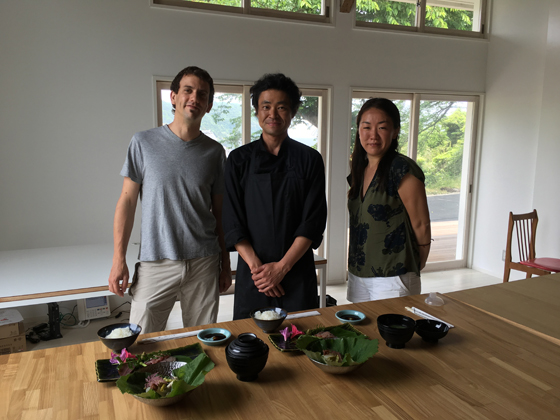
Andy and his wife, Noriko, from Germany, and Mr. Takeo Sato (center), a cooking instructor at Shimashoku no Terakoya
Learn genuine Japanese cuisine at Shimashoku no Terakoya
In June 2017, a Japanese cuisine school, Shimashoku no Terakoya, opened in the town of Ama. This is a new project to develop genuine chefs by utilizing agricultural and fishery resources in the town. A nursery school building was converted into the cooking school, and the oven, grill, and other cookware are all brand-new.
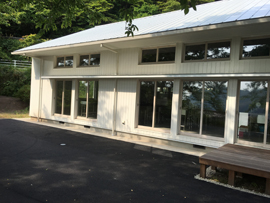
Shimashoku no Terakoya
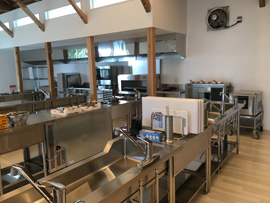
Kitchen
The cooking instructor at the school is Mr. Takeo Sato, who has run a creative Japanese cuisine restaurant in Chuo Ward, Tokyo, and also served as the official chef of the Consulate General of Japanese in Jeddah, Saudi Arabia.
”When I was serving as the official chef of the Consulate General, it was not easy to find ingredients for sushi and other Japanese dishes. However, my experience running a creative Japanese cuisine restaurant in Tokyo helped me successfully convert local ingredients into creative Japanese cuisine for ceremonial dinners hosted by the consul general. I think that this experience contributes to the wide variety of my culinary repertoire,” says Mr. Sato, whose dishes were recognized even by refined food connoisseurs in the Arab world.
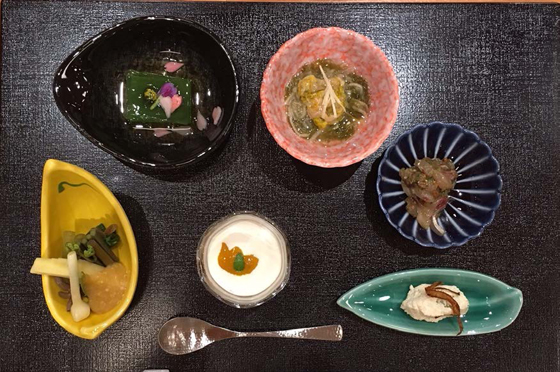
Dishes made by Mr. Sato using Ama's seasonal ingredients
Shimashoku no Terakoya’s concept for Japanese dishes is mainly based on “seasonality” and “culture.” In order to master these two elements, you need to understand the season of vegetables and fish, as well as the culture, ingredients, and local environment of foods. Among them, the most important factor is ingredients, which are seen as dependent on the chef’s polished skills and the five senses.
Mr. Sato takes a walk every morning and sees the ocean, mountains, and farmlands of Ama. Then he depicts the scenery in his dishes.
Fully understanding Japan’s cultures and climates, and also having rich experience working abroad as a capable chef, Mr. Sato is truly suitable as an instructor at Shimashoku no Terakoya, which also welcomes foreign visitors.
Enjoy a long vacation in Ama
Aside from the shared house covered in Volume 1, the town of Ama also provides rental houses where Japanese people wishing to live in Ama for a brief period, or foreign tourists who prefer a long stay in one place, can stay for a long time.
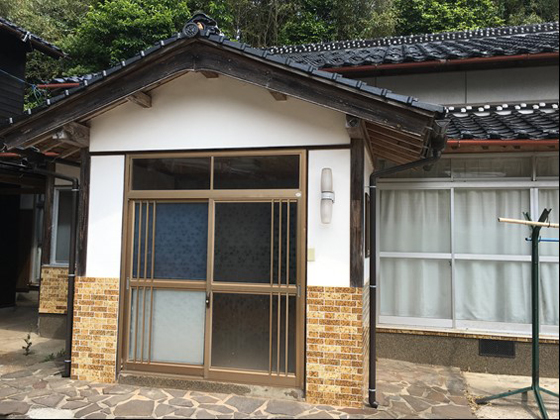
An example of a rental house
For users unfamiliar with the island, staff members at the Ama Tourism Association provide basic town information, invite them to local events, and support interaction with community members.
During my stay on the island, I met Andy and his wife, Noriko, as well as Ms. Sahara, who is Noriko’s friend, and her son, Yutaka, who is one year and two months old. They were enjoying Ama while staying at the rental house.
Ms. Sahara is Noriko’s friend from college. They met again in Ama to enjoy a vacation together, taking the opportunity of Noriko’s temporary return to Japan from Germany.
During their stay in Ama, Andy enjoys fishing, while Noriko practices kendo (Japanese fencing) with local police officers.
Shimashoku no Terakoya also provides an opportunity for tourists to experience cooking of Japanese dishes in a short time. Mr. Sato’s class on that day was to focus on how to cook dishes using Ama’s fresh ingredients, so I joined his class.
The instructor gave us various explanations, such as the fish to be cut into three slices in the class, the types of knives, and how to remove the scales from the fish. After the explanations, we started cooking under the direction of Mr. Sato.
What was most surprising to me was that Andy skillfully cut the fish into three slices, although it was his first try.
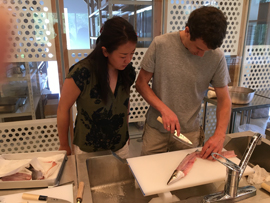
Andy cutting the fish into slices
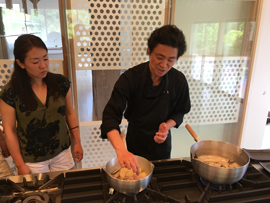
Noriko learning how to make tasty soup stock
After hearing that fish would be unloaded at Saki Port, I decided to go and take a look at them with Ms. Sahara and her son, Yutaka, who started getting cranky. On that day, there was a large catch of grunts and barracuda, and local people who heard the news were also there to buy them. And it was no wonder, because they were sold at a surprisingly affordable price. People around the area can eat ocean-fresh fish at their homes as soon as 30 minutes after purchase.
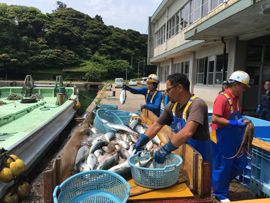
Fish unloaded at the Saki Port
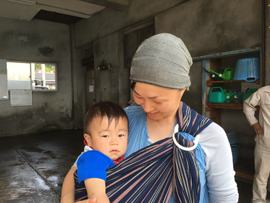
Ms. Sahara and her son, Yutaka
When we returned to the cooking school, dishes were ready. Delicious-looking sashimi was served on seasonal leaves from the hill behind the school. Andy seemed to find the Japanese sense of delicacy and the richness of the country’s four seasons in the leaves. “The experience of making Japanese dishes was very interesting, and new even to me, as a Japanese person,” said Noriko, whose words made me feel the depth of Japanese cuisine.

Barracuda sashimi made by Andy

Ms. Sahara enjoying the dishes
The next day, Andy and Noriko as well as Ms. Sahara and Yutaka were going to leave the island, so I went and met them to send them off.
Andy, Noriko, and Ms. Sahara all said that they had a relaxing time because the food was delicious and the island was rich in nature. They left Hishiura Port after saying that they were happy and comfortable with the warmth and open mind of the people of Ama, who welcome visitors to the town.
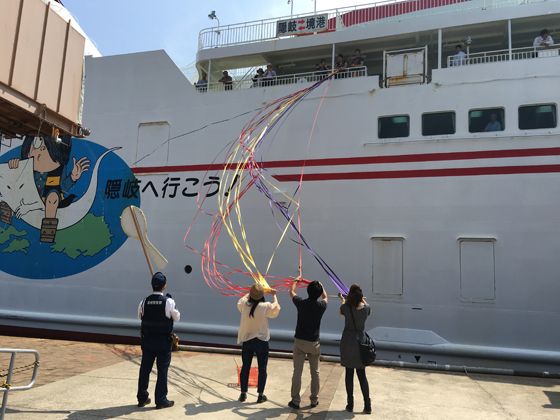
A farewell like a scene in a movie
A desire to deliver Ama’s fresh seafood
Ama is a town rich in fresh seafood. Because of the distance, however, if fish and shellfish caught in the morning are shipped by sea in the afternoon, they arrive the next day even at Sakai Port, Tottori Prefecture, on Japan’s mainland. This time lag deteriorates the freshness and causes lower priced transactions at the market, resulting in the business being less profitable.
Even so, people in the town were hoping to deliver Ama’s delicious seafood throughout the country and make it accessible to more people, as well as to galvanize the fishing industry on the island. With this background, the town introduced a freezing system called CAS (Cells Alive System).
CAS is a technology that vibrates the water molecules of ingredients using weak magnetic field energy in the freezer and rapidly freezes them by lowering the temperature to minus 55 degrees Celsius. This freezes and keeps the ingredients in a viable condition without damaging their cellular tissues. This system enables preservation of the odor, flavor, savory taste, and deliciousness of ingredients; kills parasites; and prevents the bacteria that cause food poisoning from proliferating.
This equipment was developed by a company in Chiba Prefecture. In order to start a business utilizing this technology, the town of Ama invested 500 million yen and established a third-sector company, Furusato Ama Co. Ltd., in March 2005.

CAS Freezing Center at Furusato Ama Co. Ltd.
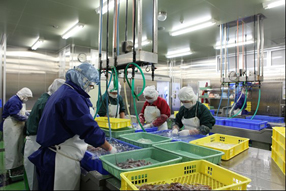
Fishery processing work
Furusato Ama Co. Ltd. is currently composed of three businesses, the CAS business being one of them. The CAS Freezing Center processes food ingredients and produces frozen foods.
It is surprising that CAS is capable of freezing ingredients without damaging freshness; thus, even if a defrosted oyster is sliced, the shape of the cross-section is maintained, and even squid can be eaten as sashimi. The taste is also great because good-tasting ingredients do not run or dissolve when defrosted.
Today, Ama’s original brand, Shimakaze-bin, delivers CAS-frozen seafood throughout the country and is winning popularity among restaurants in Tokyo. This service receives many orders on the Internet.
Due to its new capability of selling products throughout the year, Furusato Ama Co. Ltd. can now maintain a constant price for seafood from fishermen and the market. This situation allows those involved in the fishery industry to enjoy a steady income.
This project can be referred to as a best practice of local government–led business creation and regional revitalization.

Freezer at a temperature of minus 55 degrees Celsius

Frozen oysters
Captivated by dishes of Sentoraru-tei
One day I went to Sentoraru-tei, a restaurant serving dishes using CAS-frozen products, which is located on the second floor of Kinnyamonya Center at Hishiura Port.
I ordered a mix fry set meal (1,800 yen, tax included), including slices of fried CAS-frozen horse mackerel, squid and original oyster of the Haruka brand. Having no strong odor at all, the ocean-fresh seafood was fried right there for each meal.

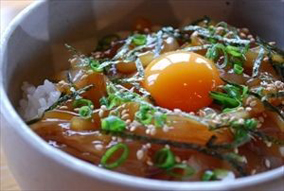
Kan-shimame zukedon (pickled flying squid rice bowl; 800 yen, tax included)
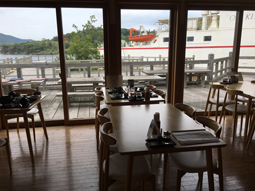
An Oki Kisen ferry anchored at Hishiura Port, viewed through the window
The most popular menu item for Japanese people is kan-shimame zukedon (pickled flying squid on rice; 800 yen), using a fresh flying squid caught in the Sea of Japan. This is a “B-grade gourmet” (ordinary yet tasty food) that won seventh place in the National Local Rice Bowl Competition in 2011. According to the restaurant, foreign customers often order fried horse mackerel.
Ama’s local seafood dishes are also available at Rito Kitchen’s Kagurazaka Branch, a restaurant in Kagurazaka, Tokyo. I think I will often visit Kagurazaka after returning to Tokyo.
Ama Tourism Association
1365-5 Ama, Oki District, Shimane Prefecture
Tel: 08514-2-0101
Website: http://oki-ama.org/ (Japanese site only)
Rito Kitchen, Kagurazaka Branch
6-23 Kagurazaka, Shinjuku, Tokyo, 162-0825
Tel: 03-6265-0368
Website: http://ritokitchen.com/ (Japanese site only)
